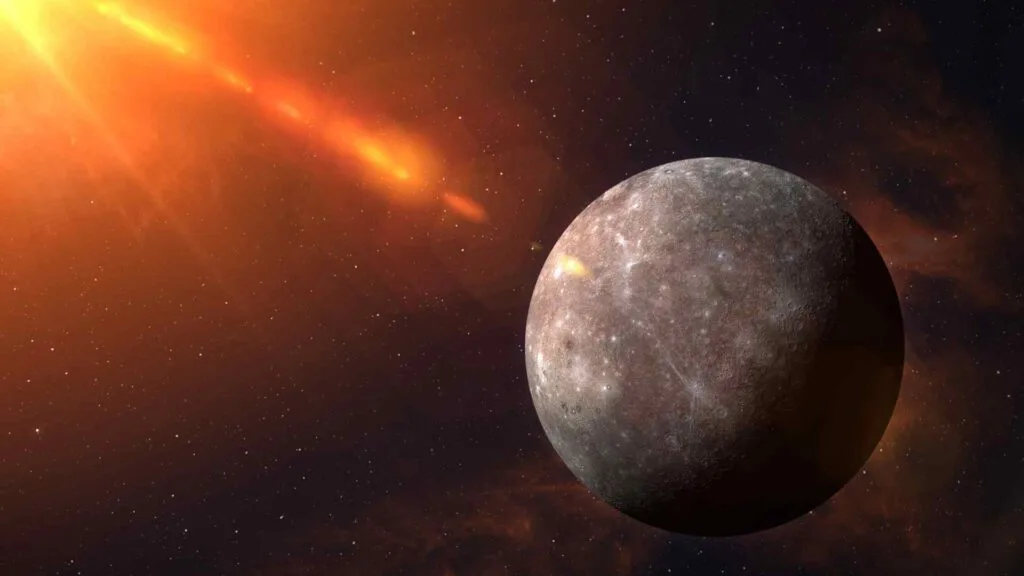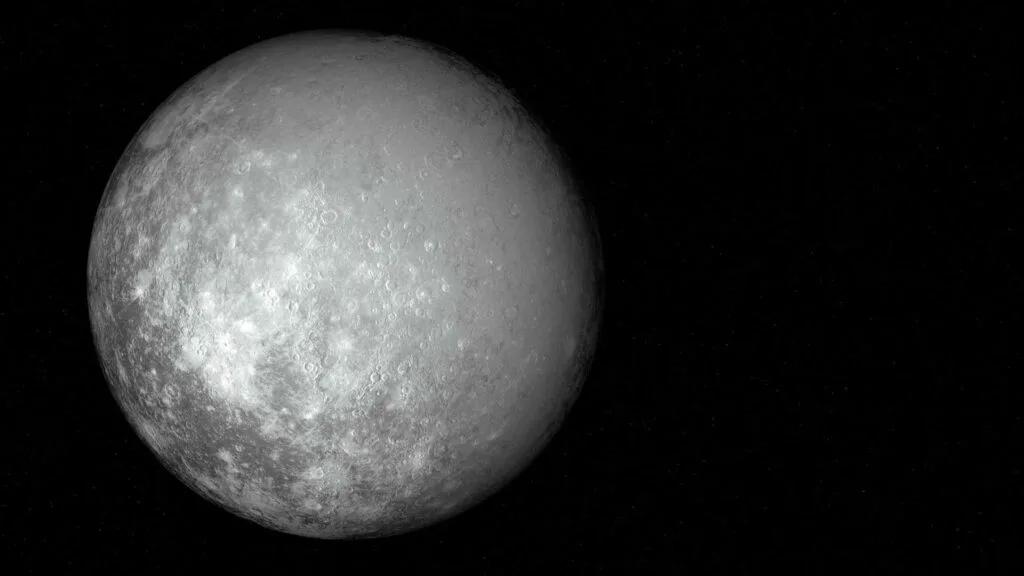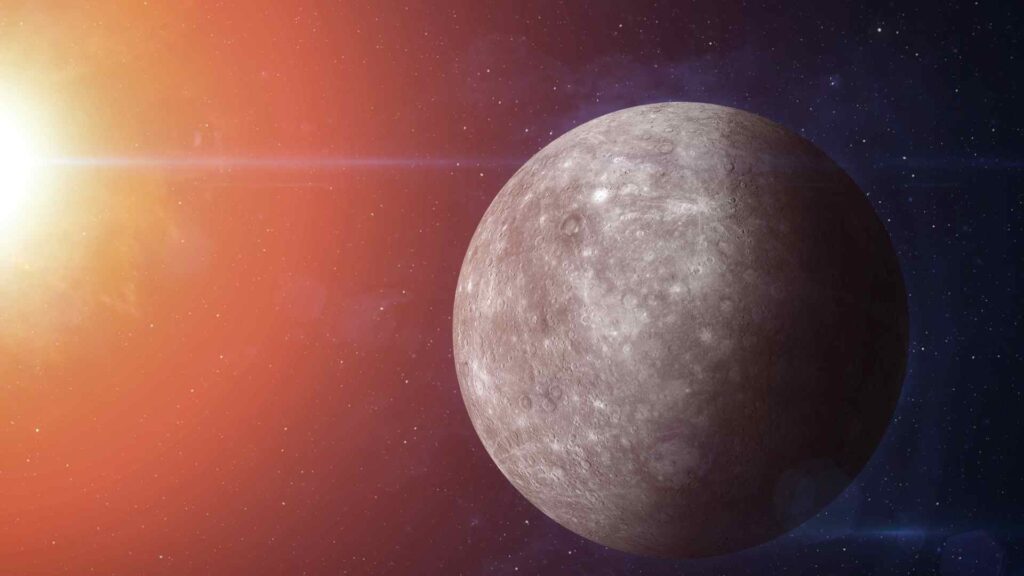Mercury, the smallest planet in our solar system and closest to the Sun, is often overlooked, but it holds a treasure trove of curious, quirky, and downright amazing facts.
Ready to uncover some surprising and humorous insights about Mercury? Let’s get started with our Mercury fun facts!
Mercury’s Physical Characteristics
- Mercury is the smallest planet in our solar system, measuring just 4,880 kilometers (3,032 miles) across.
- It’s about 38% the diameter of Earth, making it slightly larger than our Moon.
- Despite its size, Mercury is dense, with a core making up about 85% of its radius.
- Mercury has no moons or rings, unlike most other planets in our solar system.
- The planet has a high iron content, contributing to its density and gravity.
- Its surface gravity is just 38% of Earth’s, meaning you’d weigh much less on Mercury!
- Mercury’s thin silicate crust is similar to Earth’s in composition.
- The planet has a dark surface that reflects only about 6% of sunlight, making it hard to see from Earth.
- Due to solar wind exposure, Mercury is covered in fine dust and has a grayish, rocky appearance.
- Despite being close to the Sun, Mercury has a lot of ice hidden in permanently shadowed craters.
- Unlike Earth, Mercury lacks tectonic plates, leading to unique landforms and wrinkle ridges.
- Mercury’s low axial tilt means it has almost no seasonal temperature changes.
- The planet has a weak magnetic field, about 1% as strong as Earth’s.
- Its magnetic field is believed to be generated by a partially molten core.
- Mercury’s unique composition and density have fascinated scientists for centuries.

Mercury’s Orbit and Rotation
- Mercury has the most elliptical (oval) orbit of any planet, ranging between 46 million and 70 million kilometers from the Sun.
- Its orbit takes just 88 Earth days, making it the fastest planet to orbit the Sun.
- A day on Mercury (one full rotation) takes 59 Earth days.
- Because of its slow rotation and fast orbit, one solar day on Mercury is 176 Earth days!
- Mercury’s axis has almost no tilt, remaining upright as it orbits the Sun.
- Mercury occasionally experiences a phenomenon called “solar transit,” where it passes directly between the Earth and Sun.
- It’s the only inner planet that has both a highly eccentric orbit and synchronous rotation.
- When Mercury is at perihelion (closest to the Sun), it travels faster than at aphelion (farthest point).
- Mercury’s orbital speed reaches over 47 kilometers per second.
- Its eccentric orbit results in an unusual “double sunrise” effect as the Sun appears to rise, set, and rise again in some places.
- The planet completes three rotations on its axis for every two orbits around the Sun.
- Mercury’s orbit and rotation patterns create a unique, complex day-night cycle.
- Because of its orbit, Mercury’s appearance in the sky changes significantly from night to night.
- Sometimes, Mercury is visible from Earth, but its closeness to the Sun makes it tricky to observe.
- Due to gravitational effects, Mercury’s orbit is slowly shifting, a phenomenon called precession.
Temperature Extremes on Mercury
- Mercury has one of the most extreme temperature ranges in the solar system.
- Daytime temperatures on Mercury can reach up to 430°C (800°F).
- Nighttime temperatures plummet to -180°C (-290°F), a huge difference of over 600 degrees Celsius.
- These temperature shifts occur due to the lack of atmosphere to retain heat.
- Despite its extreme temperatures, water ice can persist in permanently shadowed craters.
- Mercury’s temperatures vary greatly depending on latitude and time of day.
- The poles are much cooler than the equator, with certain areas never seeing sunlight.
- Temperature fluctuations have led scientists to hypothesize about unusual rock formations.
- Mercury’s surface materials appear to be resilient to temperature expansion and contraction.
- The planet’s lack of seasons contributes to its temperature extremes.
- Despite being closer to the Sun than Venus, Mercury is cooler than Venus due to its lack of a thick atmosphere.
- The rapid heating and cooling create stress fractures on Mercury’s surface.
- Solar flares from the Sun occasionally affect Mercury, raising surface temperatures briefly.
- Mercury’s coldest regions are some of the most stable places for water ice.
- The temperature differences make Mercury’s environment inhospitable for life as we know it.

Mercury’s Unique Surface Features
- Mercury’s surface is covered in craters, much like our Moon.
- The largest crater on Mercury is the Caloris Basin, measuring about 1,550 kilometers across.
- Mercury has a vast network of ridges, or “rupes,” likely formed from the planet’s cooling and shrinking.
- It has regions called “intercrater plains” that are relatively smooth and crater-free.
- Mercury’s surface is scarred with ancient volcanic deposits and lava plains.
- Unlike Earth, Mercury doesn’t have any active volcanoes today.
- There are regions called “hollows” on Mercury that appear to be eroded or collapsed areas.
- These hollows are unique to Mercury and may form from volatile materials vaporizing.
- Some craters on Mercury have “central peaks” due to rebound effects from impacts.
- The planet’s terrain is heavily fractured and fragmented, reflecting its violent past.
- Mercury’s surface brightness varies, creating a distinct “patchwork” of light and dark areas.
- The absence of water erosion means that Mercury’s surface features remain well-preserved.
- Some ridges and faults on Mercury are over 1,000 kilometers long.
- Mercury has “wrinkle ridges,” which result from its crust contracting as it cooled.
- The planet’s landscape is dotted with impact features dating back billions of years.
Mercury’s Atmosphere and Exosphere
- Mercury technically doesn’t have an atmosphere; it has an exosphere made of scattered atoms.
- The exosphere is composed of oxygen, sodium, hydrogen, helium, and potassium.
- Solar wind continually strips particles away from Mercury’s surface, replenishing the exosphere.
- The exosphere is so thin that Mercury’s sky appears completely black, even during the day.
- Micrometeoroid impacts help to sustain Mercury’s exosphere by releasing surface materials.
- Mercury’s exosphere is transient, with gases constantly escaping into space.
- The planet has no atmospheric pressure due to the thinness of its exosphere.
- Solar radiation contributes to the presence of sodium and potassium in the exosphere.
- Unlike Earth, Mercury’s exosphere doesn’t provide any protection from the Sun’s radiation.
- Mercury’s lack of atmosphere means there’s no weather or cloud formation.
- The atoms in Mercury’s exosphere are so sparse they rarely collide with each other.
- Magnetic interactions between the planet and the Sun affect Mercury’s exosphere.
- The composition of Mercury’s exosphere changes as it interacts with solar winds.
- The existence of an exosphere was confirmed by ground-based telescopes.
- Mercury’s exosphere is one of the most dynamic of all the rocky planets.
Mercury in Ancient History and Culture
- Mercury was known to ancient civilizations and was named after the Roman messenger god.
- The Babylonians called Mercury “Nabu,” after their god of wisdom.
- Ancient Greeks referred to Mercury as “Apollo” when visible in the morning and “Hermes” when seen in the evening.
- Many cultures viewed Mercury as a symbol of change, travel, and communication.
- Mercury’s swift movements led to its association with speed and agility in mythology.
- The planet was often linked to commerce, given its association with the god of trade.
- The ancient Chinese astronomers called Mercury “Chen Xing,” the “Hour Star.”
- Ancient Romans identified Mercury as the god of eloquence, due to its bright, fleeting nature.
- In Hindu mythology, Mercury is known as “Budha” and is associated with wisdom.
- Mercury’s visibility in the sky made it one of the five “wandering stars” observed by early astronomers.
- The Mayans and Aztecs also had records of Mercury, viewing it as a symbol of duality.
- Many cultures saw Mercury as a guide for the souls of the deceased.
- Mercury’s appearances and disappearances were often linked to omens or changes in fortune.
- Medieval European astrologers associated Mercury with intellect and communication.
- Alchemists once considered Mercury to represent the element of mercury (quicksilver), symbolizing transformation.

Exploration Missions to Mercury
- The Mariner 10 mission was the first spacecraft to visit Mercury in 1974.
- Mariner 10 provided the first close-up images of Mercury’s surface.
- NASA’s MESSENGER mission orbited Mercury from 2011 to 2015.
- MESSENGER discovered evidence of water ice in Mercury’s polar craters.
- The BepiColombo mission, launched in 2018, is currently en route to study Mercury.
- BepiColombo is a joint mission by the European Space Agency and the Japan Aerospace Exploration Agency.
- MESSENGER mapped nearly the entire surface of Mercury for the first time.
- Mariner 10 used Venus to perform a gravity assist to reach Mercury.
- BepiColombo will perform multiple flybys to reach Mercury’s orbit by 2025.
- Early missions had to overcome Mercury’s proximity to the Sun and intense heat.
- MESSENGER was the first mission to confirm Mercury’s magnetic field.
- Mariner 10 discovered Mercury’s thin atmosphere and unusual terrain.
- BepiColombo aims to study Mercury’s magnetosphere, surface, and exosphere.
- BepiColombo is designed to withstand the intense sunlight and heat near Mercury.
- Future missions may seek to land on Mercury’s surface to study its composition up close.
Interesting Comparisons with Other Planets
- Mercury is smaller than both Ganymede (a moon of Jupiter) and Titan (a moon of Saturn).
- It is the closest planet to the Sun, while Neptune is the farthest.
- Mercury’s orbit is more eccentric than those of other planets.
- Venus, the second planet from the Sun, is hotter than Mercury due to its thick atmosphere.
- Mercury has less gravitational pull than Earth, despite its high density.
- Mars, further from the Sun, has seasons, unlike Mercury.
- Mercury’s day-night temperature difference is far greater than any other planet.
- The lack of an atmosphere on Mercury makes its surface more cratered than Earth’s.
- Mercury’s year (88 Earth days) is shorter than Venus’s day (243 Earth days).
- Unlike Earth, Mercury has no tectonic plate activity, impacting its surface evolution.
- Jupiter’s moon Io is volcanically active, while Mercury is geologically inactive.
- Mercury is similar to the Moon in appearance, but its iron core is much larger.
- Both Mercury and Venus lack moons, a rare feature among inner planets.
- Mercury’s magnetic field is weaker than Earth’s but unique among inner planets.
- Unlike gas giants, Mercury has a rocky surface with no significant atmosphere.
Bonus: Mercury-Themed Puns and Jokes
- “Why don’t Mercurian aliens ever get married? They just can’t commit!”
- “How does Mercury keep cool? It has some really ‘chill’ craters!”
- “What’s Mercury’s favorite exercise? Sunbathing!”
- “Mercury is the life of the ‘orbit’ party!”
- “Why can’t you trust Mercury? It’s just too ‘hot’ to handle!”
- “Mercury tried to break the ice… and succeeded at its poles!”
- “Mercury says, ‘Gravity? No pressure!’”
- “Mercury is a big ‘core’ value kind of planet.”
- “Why did Mercury join the band? It has great ‘rock’ skills!”
- “Mercury’s motto: No atmosphere, no problem.”
- “What’s Mercury’s favorite movie genre? Space comedies!”
- “Why did Mercury stop hanging out with Venus? Too much ‘hot’ drama!”
- “Mercury tried surfing the solar wind but wiped out!”
- “When Mercury says ‘cool down,’ it means -300°F!”
- “Mercury never has to worry about weight loss — no atmosphere!”
- “Mercury: always the ‘hot shot’ in the solar system.”
- “Mercury likes to keep things ‘dark and moody’ — no light pollution.”
- “Mercury’s secret to its speed? A highly elliptical diet!”
- “Mercury doesn’t do ‘seasons’ — it prefers extremes.”
- “Why is Mercury such a good friend? It’s down to Earth!”
- “Mercury wanted to go to the Sun but decided to keep a safe distance.”
- “Mercury would win at hide and seek — you can barely spot it in the sky!”
- “Mercury’s favorite band? The Red Hot Solar Peppers!”
- “Why don’t astronauts visit Mercury for vacations? Too much sunburn!”
- “What’s Mercury’s motto? It’s a rocky road, but I’m rolling with it!”
- “Mercury and Venus walked into a bar… and melted it!”
- “Mercury’s New Year’s resolution? To keep orbiting at top speed!”
- “Mercury went on a date with Earth, but they just couldn’t orbit each other.”
- “Mercury’s guilty pleasure? Spacing out!”
- “How does Mercury deal with bad weather? It simply doesn’t!”
- “Why doesn’t Mercury get invited to solar system picnics? It’s too extreme!”
- “What’s Mercury’s favorite breakfast? Cosmic dust pancakes.”
- “Mercury’s secret to happiness: embracing the ups and downs of orbit.”
- “Mercury has a strong core but a thin skin!”
- “Why does Mercury feel left out? No rings, no moons, just vibes.”
- “Mercury’s favorite song? ‘You’re So Hot and Cold’ by Katy Perry.”
- “How does Mercury like its sunrises? Extra crispy!”
- “Mercury says, ‘Light years? Please, I run on pure solar energy!’”
- “Why did Mercury break up with Jupiter? Too much gravity in the relationship.”
- “What does Mercury do on weekends? Just kicks back and rotates!”
- “Mercury’s pickup line: ‘Are you solar wind? Because you blow me away!’”
- “Why does Mercury prefer to stay single? No atmosphere, no drama.”
- “Mercury’s secret hobby? Watching Earth rise from afar!”
- “What does Mercury wear to a planet party? A slick, rocky outfit!”
- “Mercury’s slogan? ‘Cooler than you’d think.’”
- “Mercury: where the weather forecast is always ‘extreme.’”
- “Why doesn’t Mercury play baseball? It’d just strike out in orbit!”
- “Mercury’s advice? ‘Stay grounded but keep your orbit interesting!’”
- “Why does Mercury love the Sun? It always brightens its day!”
- “Mercury’s favorite workout? High-intensity interval orbiting!”
Conclusion
Mercury may be the smallest planet in our solar system, but it’s packed with surprising, extreme, and fascinating characteristics!
From its scorching days to frigid nights, Mercury is a planet of contrasts and mysteries that has inspired awe, curiosity, and even a bit of humor throughout history.
Whether you’re a space enthusiast or just along for a cosmic laugh, we hope these facts and puns about Mercury have brightened your day and expanded your appreciation for this enigmatic planet.
